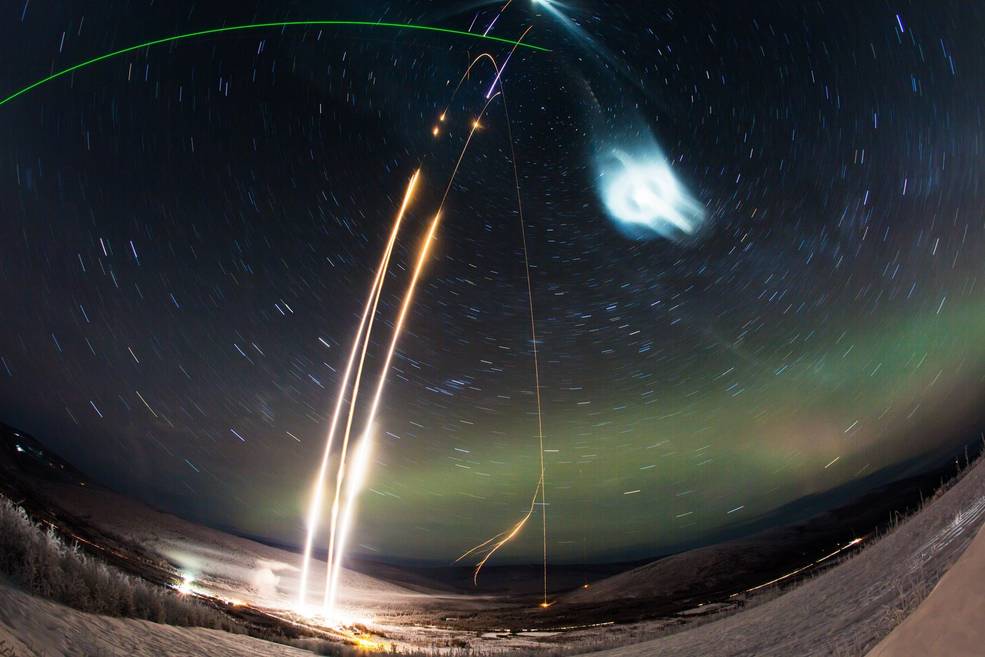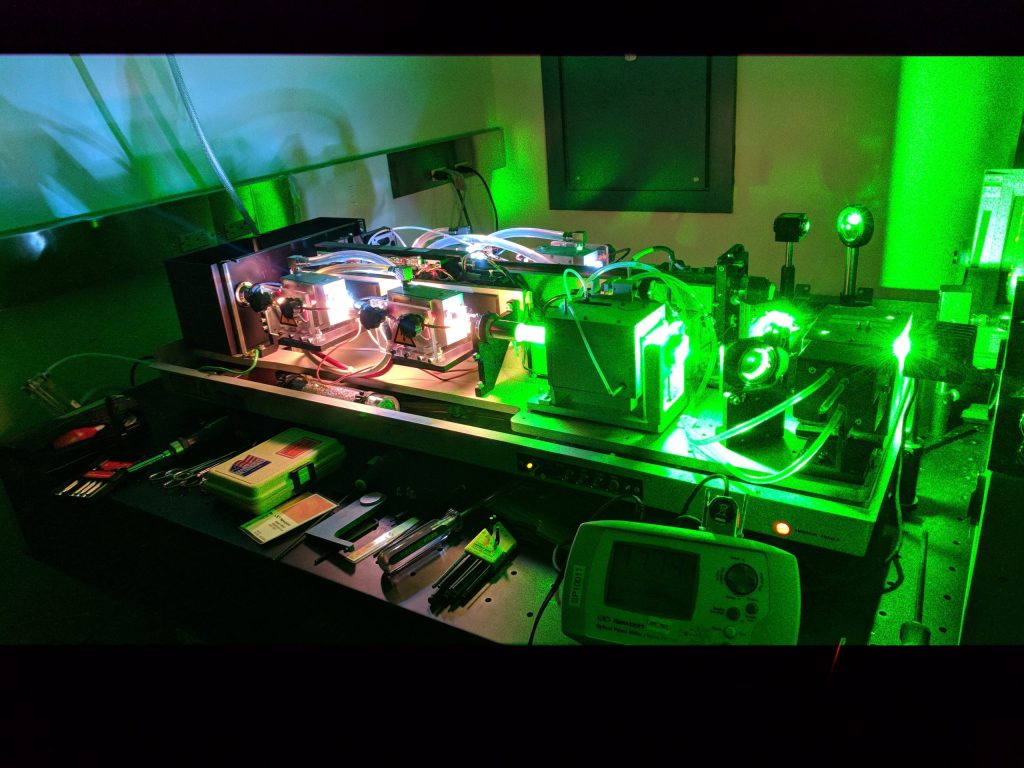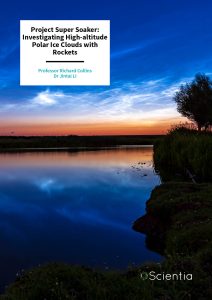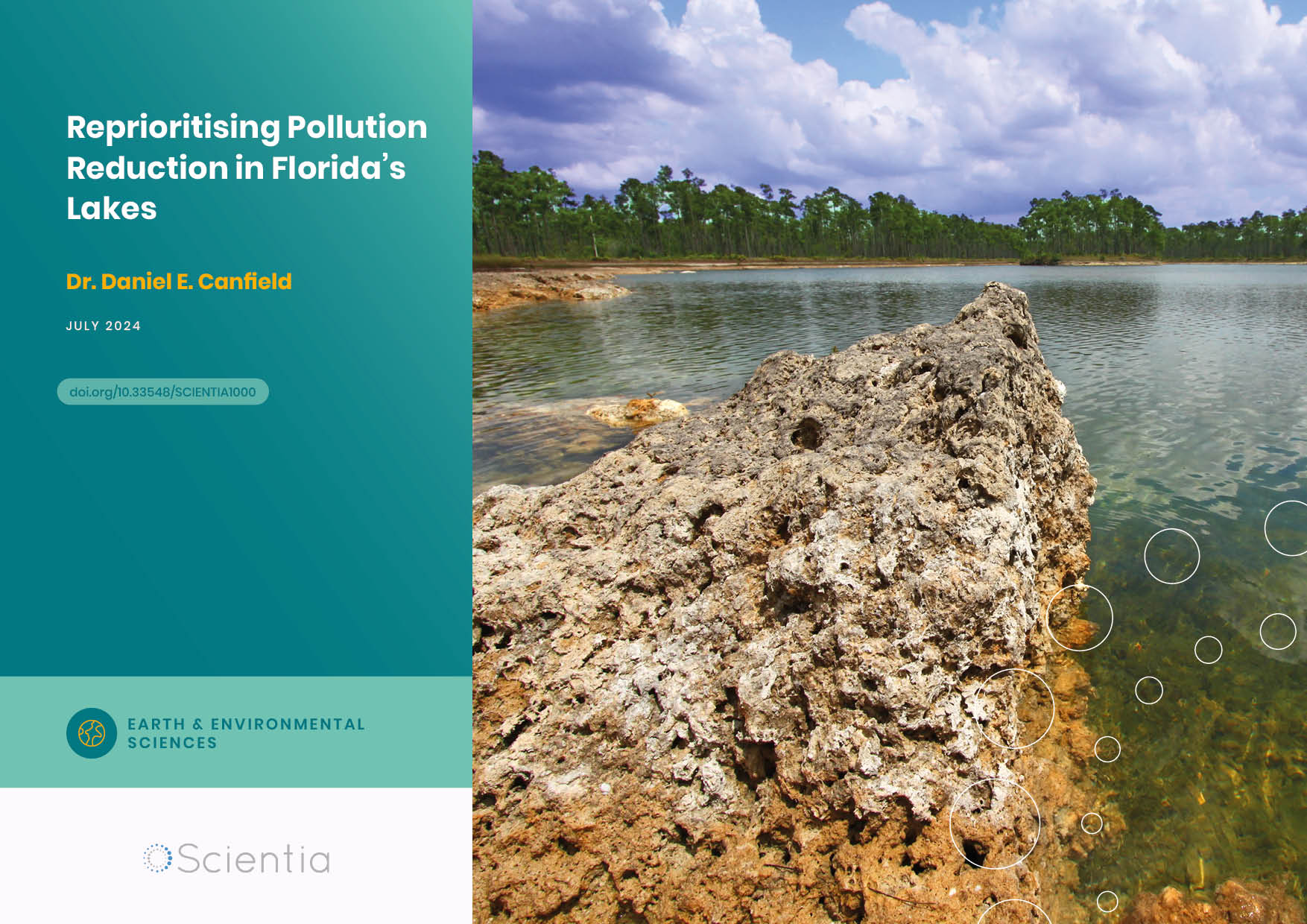Professor Richard Collins – Dr Jintai Li | Project Super Soaker: Investigating High-altitude Polar Ice Clouds with Rockets
Phenomena in the upper atmosphere are difficult to study for several reasons – some rarely form, others are difficult to see, and all are incredibly high up. Polar Mesospheric Clouds (PMCs) are no exception, forming at around 80 kilometres up into the sky, only under specific atmospheric conditions, and only visible to the naked eye during twilight. PMCs are also called noctilucent or ‘night-shining’ clouds, as they appear to glow in the summer nighttime sky. Professor Richard Collins from the University of Alaska Fairbanks is using rockets to seed these clouds, allowing better investigations of both PMCs and the effects of space traffic on our upper atmosphere.
Some Clouds in the Sky
When a space vehicle launches, a long tail of clouds forms behind it. This cloud is formed of water vapour from the exhaust of the rocket, in the same way as contrails form behind high-flying aircraft. As the rockets ascend, they travel through all layers of the atmosphere. One such layer is the mesosphere. Lying between 50 and 80 kilometres, the mesosphere is far beyond the reach of aircraft and only the lowest few kilometres are accessible to balloons. This makes it tricky to study, although many of the phenomena that exist within it are of considerable interest to researchers.
Polar mesospheric clouds (PMCs) are a fascinating example of mesosphere phenomena. These clouds of water ice particles form during the polar summer on the upper edges of the mesosphere, in extremely cold and dry conditions. They are much less likely to form in the winter when the mesosphere above the poles is warmer than the summer temperature. The sensitivity of these clouds to temperature and humidity variations makes them an ideal candidate to study the meteorological conditions and processes of the upper atmosphere.
Previous research has shown more PMCs form when the number of space vehicles travelling through the mesosphere increases, but the mechanisms behind this have remained elusive until recently. To solve the mystery, Professor Richard Collins and Dr Jintai Li at the University of Alaska Fairbanks and their colleagues from seven labs and universities across the USA developed ‘Project Super Soaker’ with support from NASA. The plan was to deliver a payload of water vapour into the upper atmosphere to form an artificial polar mesospheric cloud (PMC), which could then be investigated to determine the effects of concentrated water vapour on the atmosphere.

Time lapse of the Super Soaker launch. Three rockets launched with the mission, two using vapour tracers to track wind movement and one releasing a water canister to seed a polar mesospheric cloud. The green laser beam visible at the top left is the lidar beam used to measure the artificial cloud. Credits: NASA’s Wallops Flight Facility/Poker Flat Research Range/Zayn Roohi https://www.nasa.gov/missions/sounding-rockets/nasa-mission-seeks-to-understand-bright-night-shining-clouds-by-creating-one/
Cloud Technology
Professor Collins’ team constructed three sounding rockets to carry out Project Super Soaker. Two rockets contained tracers to calibrate atmospheric conditions; the third carried a payload of 220 kilograms of liquid water set to detonate at 85 kilometres. By releasing a large amount of water vapour at once, the team would soak the region with water and more easily measure the effects. The mission was carried out in January when PMCs are less likely to naturally form, meaning only the artificially created PMC was present.
Measuring the PMC had to be achieved from the ground, as the formation occurs too high for any aircraft, and the formed cloud is too small for satellite imaging. Professor Collins’ team used an array of instruments to measure the conditions and clouds. A lidar (light detection and ranging) unit was designed to measure light scattering off the ice crystals forming the PMC, giving the team information on the cloud’s size, shape, altitude, temperature, and density. A second lidar was calibrated to measure the wind and temperature, recording the critical meteorological conditions in which the cloud formed. Finally, an infra-red temperature mapper gave the temperature of a wide area around where the PMC forms. Armed with this array of rockets and measuring equipment Professor Collins’ team launched their rockets on the night of the 25th of January 2019.
Formation and Measurement
Professor Collins and his team started detecting a potential PMC 18 seconds after detonation and were able to track the object for a further three minutes. Looking at the data, the team had several critical questions to be answered.
The first was whether a PMC had formed at all. The Lidar readings could originate from several sources; remaining liquid water from the detonation; debris from the payload; other rocket exhaust products; or a PMC. Looking at previous studies such as the ‘High Water’ experiments in the 1960s; calculating the trajectory of debris; and previously observed space vehicle mesospheric cloud formations, Professor Collins confirmed that the object formed was indeed a PMC, as hoped.
The second was that PMCs are only rarely seen at temperatures above 150 Kelvin (-123°C), but the initial temperature readings were around 200 (-73°C) Kelvin. Professor Collins explains that there are two mechanisms at play allowing such a cloud to form. First, the higher concentration of water lowers the frost point, allowing the cloud to form at a higher temperature. Second, the water vapour from the rocket forms a filamentary structure which drives a local cooling of the area. The rapid cooling of the local area and a reduced frost point allow the clouds to be formed out of season.
Finally, the cloud was seen to rapidly descend from its formation point, much faster than any winds or gravity would carry it. However, Professor Collins explains that this reading wasn’t showing the whole picture; the cloud was instead expanding from the point of detonation. The Lidar measurement was only seeing the bottom edge of the cloud expanding downwards, while the rest of the cloud would have been expanding upwards and sideways.

Credit: Jintai Li, 2018
Making a Splash…
Professor Collins and his team’s work on Project Super Soaker has provided us with a wealth of information on the effects space vehicles have on the upper atmosphere. The water vapour introduced by space vehicles not only is a source for mesospheric clouds that raises the frost point but also simultaneously lowers the local temperature to induce the formation of PMCs.
Professor Collins states that whilst some further questions on the physics of mesospheric clouds may lie just beyond our current technological grasp, the area is primed for further investigation. With Project Super Soaker, Professor Collins and his team have shown that sometimes, the most interesting results come from making a big splash.
SHARE
DOWNLOAD E-BOOK
REFERENCE
https://doi.org/10.33548/SCIENTIA997
MEET THE RESEARCHER

Professor Richard Collins
Department of Atmospheric Sciences and Geophysical Institute
University of Alaska Fairbanks
Fairbanks, AK
USA
Professor Richard Collins earned his PhD in electrical engineering from the University of Illinois in 1994. Supported by his experience of Antarctic conditions from a previous visiting winter scientist position at the Amundsen-Scott South Pole Station, Professor Collins has gone on to contribute to many areas of atmospheric research. Having been based at the University of Alaska Fairbanks since 1994, Professor Collins’ research utilises many methods to investigate the atmosphere, including rockets, lasers and radar. Professor Collins teaches both undergraduate and postgraduate students, lecturing on electrical engineering and atmospheric science and has received awards for his outstanding teaching and impactful research. He is the current treasurer of the Geoscience and Remote Sensing Society (part of the Institute of Electrical and Electronic Engineers), and has served as a member of the Living With a Star Program Advisory Panel.
CONTACT
E: rlcollins@alaska.edu
W: https://lrlpfrr.community.uaf.edu/

Dr Jintai Li
Geophysical Institute
University of Alaska Fairbanks
Fairbanks, AK
USA
Dr Jintai Li completed his undergraduate studies at the University of Science and Technology of China. In 2019, he gained a PhD from the University of Alaska Fairbanks in atmospheric science for his thesis ‘Lidar and Radar Studies of Turbulence and Waves in the Arctic Middle Atmosphere’, and since then has continued to work studying our planet’s atmosphere. After graduation, he worked as a postdoctoral fellow at Clemson University. Currently, Dr Li is an Assistant Professor at the Geophysical Institute of the University of Alaska Fairbanks. Dr Li has contributed to a large number of conference presentations and academic papers, concentrating on the application of lidar technology to atmospheric and space science.
CONTACT
FUNDING
National Aeronautics and Space Administration (NASA), USA
National Science Foundation (NSF), USA
FURTHER READING
RL Collins, MH Stevens, I Azeem, et al., Cloud Formation From a Localized Water Release in the Upper Mesosphere: Indication of Rapid Cooling, Journal of Geophysical Research: Space Physics, 2021, 126(2), e2019JA027285. DOI: https://doi.org/10.1029/2019JA027285

REPUBLISH OUR ARTICLES
We encourage all formats of sharing and republishing of our articles. Whether you want to host on your website, publication or blog, we welcome this. Find out more
Creative Commons Licence (CC BY 4.0)
This work is licensed under a Creative Commons Attribution 4.0 International License. 
What does this mean?
Share: You can copy and redistribute the material in any medium or format
Adapt: You can change, and build upon the material for any purpose, even commercially.
Credit: You must give appropriate credit, provide a link to the license, and indicate if changes were made.
SUBSCRIBE NOW
Follow Us
MORE ARTICLES YOU MAY LIKE
Dr Robert Larkin | Cultivating Change to Improve Soil Health and Increase Potato Yield
Environmental quality and food production are facing the pressing challenges of climate change and global population growth. Dr Robert Larkin from the United States Department of Agriculture-Agricultural Research Service (USDA-ARS) and a team of plant scientists developed and tested a range of crop management systems to help overcome these compounding challenges. Their work is improving soil health and increasing the yield of potato crops, contributing to the future food security of nations.
Dr Arne Stensvand | Thermotherapy: Effective Disease and Pest Management Without Chemicals
Dr Arne Stensvand and his team at the Norwegian Institute of Bioeconomy Research are developing physical methods of pest reduction in plants. The team is specifically interested in strawberry plants, for which pest management is vital for crop success. They are pioneering thermotherapy as a heat treatment method to provide an environmentally effective and economically sound non-chemical approach to pest management.
Dr. Daniel Canfield | Reprioritising Pollution Reduction in Florida’s Lakes
Florida’s landscape is dotted with thousands of lakes that reflect regional geology, topography and anthropogenic activities. Phosphorus and nitrogen are critical nutrients for maintaining the wide range of biological production expressed across Florida, but excessive inputs of these nutrients due to past human activities impair many waters. There has been a long history of work aiming to address associated water quality pressures, and Dr. Daniel Canfield at the University of Florida has been at the centre of these efforts for over 40 years. Now, with the correction of point-source nutrient inputs, Dr. Canfield proposes that holistic lake management, including the integration of in-lake management strategies with a focus on organic sediment removal, should be much more prominent on the US government’s agenda to provide faster restoration of stakeholders’ lake usability.
Dr Jon Tore Lieng | Dynamically Installed Anchors for Floating Offshore Turbines
Effectively harnessing offshore wind presents a valuable opportunity to increase energy supplies. Floating wind turbines present several advantages over traditional fixed turbines in more shallow waters. Dr Jon Tore Lieng from Deep Sea Anchors and colleagues have developed a type of dynamically installed anchor to hold the structures in place while reducing both the costs and complexity associated with installation where cohesive seabed sediments are realised.





